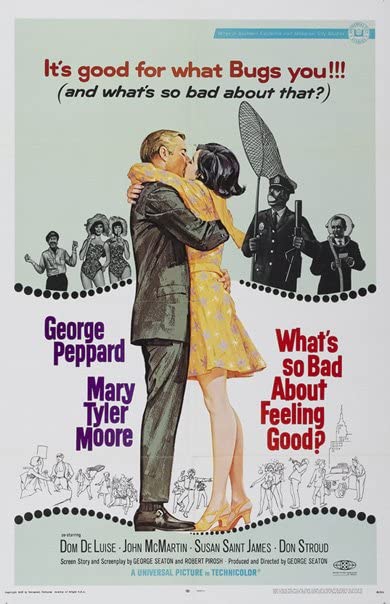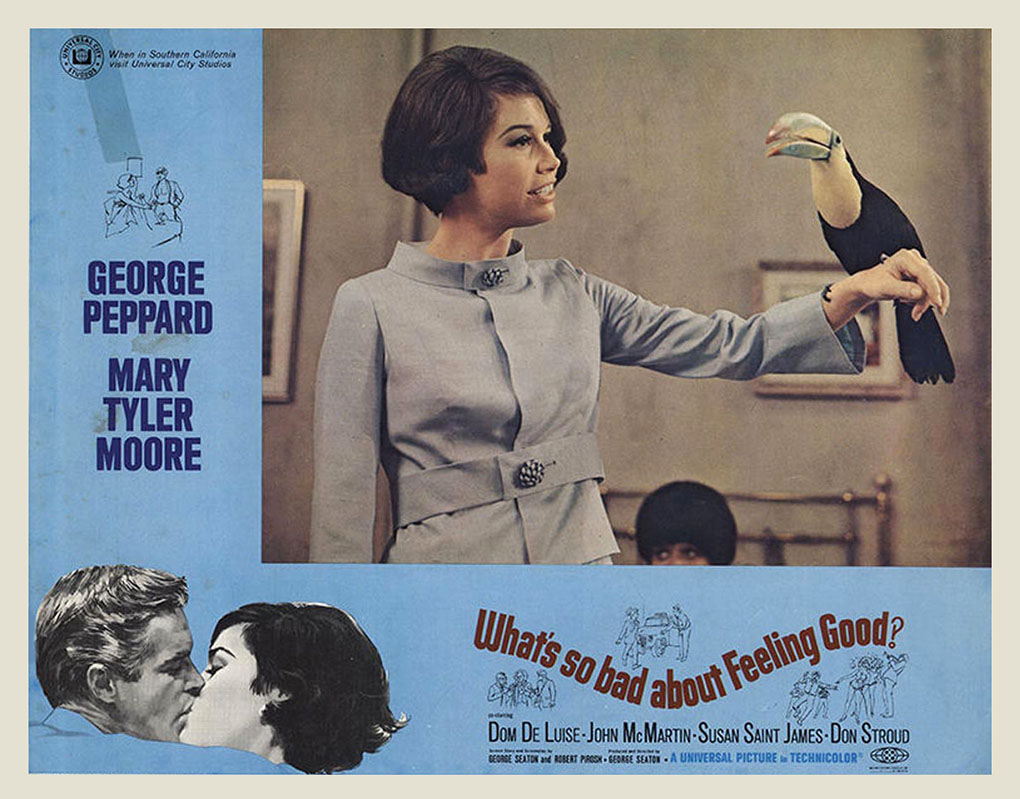George Peppard and Mary Tyler Moore Spread a Pandemic Worth Catching
DIRECTOR: GEORGE SEATON/1968
BLU-RAY STREET DATE: AUGUST 24, 2021/KL STUDIO CLASSICS

I cannot imagine a weirder movie to watch in 2021.
The premise: An airborne virus appears in New York City thanks to a flying animal traveling from across the sea. The government knows little except that it spreads via close contact with infected people, so they encourage citizens to spread out, wear face masks, and report to hospitals for testing. An elected official in New York makes broadcasts about public safety, and plenty of skeptics question whether this virus is real. For audiences in 2021, this plot is a familiar trauma, but for audiences in 1968, it was a fantasy comedy!
George Peppard and Mary Tyler Moore star as Pete and Liz, two Beatnik-Hippie loafers moping their days away in an apartment commune, writing songs like “Life Was Meant to Be Blue” and subscribing to pessimistic German philosophy. ”You take a look at the front page and then try laughing,” Liz cries. “The world’s a stinking, hopeless mess!” Such malaise has driven one of their comrades-in-woe to wear a burlap sack so generously cut it only reveals her bare feet. The cure for their self-righteous misery and political disillusionment? Well, that would be a magical toucan, of course.
This toucan, nicknamed Amigo, spreads cheer and hope wherever he goes. One whiff of him, and—ZOING!—your fears and cynicism melt for delight and optimism. Pete, Liz, and their friends cut their hair and head back to work. As the virus spreads, the line for marriage licenses spikes, alcohol and tobacco sales plummet, advertisers begin telling the truth, and strangers treat each other with politeness instead of judgment. In short, this disease makes everybody squares, but once you’ve got it, there’s no denying it’s hip to be square.

In 2021, a virus doesn’t sound like fantasy, but a cultural good mood sure does. Notably, 1968 was also a fraught year for America, and there’s been plenty of debate about whether it was better or worse than 2020. What’s So Bad About Feeling Good? premiered between the assassinations of Martin Luther King, Jr. and Robert F. Kennedy; if its opening day came after the Democratic National Convention, its release might have felt in poor taste.
I understand if you think a happiness epidemic sounds not just implausible but irresponsible in 2021, but I’ll also ask you to just shuffle on down to the movie’s bunker with the Virus Czar (Dom DeLuise) and his task force. What’s So Bad About Feeling Good? is deeply silly, deeply sanguine, and remorseless about all of it. Peppard and Moore are winsome as ever, but Pete and Liz are hardly characters. The protagonist driving the action is a plucky toucan, and Amigo’s antagonists are the team of self-important control freaks worrying a good mood will slow the economy and assuage the anxieties that drive voters. They suspect Communists created this avian flu in a lab, but these buffoons are just chasing down a bird brain with thought bubbles like, “New York is a nice place to visit, but I wouldn’t want to live here.” The title beats you to all the sarcasm you want to hurl at its dewy eyes, and its theme song challenges you, “What’s so wrong with that happy sensation, that sense of utter elation?” before the opening credits end. If they’d had the special effects budget, director George Seaton might have made the Statue of Liberty lead a deus ex machina dance parade to the tune.

The commentary track by historians Howard S. Berger and Nathaniel Thompson runs an even higher fever for this film than I do, perhaps because this is its first home video release ever. In addition to complimenting its satire, they bring background into how this title fits into Seaton and Peppard’s careers, its depiction of the ’60s counter-culture, and its comparison to other Universal films of the time.
So say what you will about this very ‘60s movie with a very sunny outlook, but it improved my mood in minutes. The poppy color palette and swinging style make New York City look downright romantic on this Blu-ray, so much so you might find yourself agreeing with the guy who suggests tearing down the Stock Exchange to build a park. Heck, if nothing else, a Thelma Ritter cameo will put you in a good mood, right? (Because it definitely won’t be Peppard’s non-consensual kissing to spread the virus—woof). I’m not sure “prescient” is the correct word for its take on how people respond to a public health crisis, but its insight is more accurate than you’d expect for a lighthearted, high-concept comedy. But the social commentary is a bonus here—the real draw is the consistent level of charm. From the toucan antics (toucantics?) to Peppard’s WALL-E moment discovering a flower in a pile of garbage, it’s deeply slapstick, deeply sincere, and for 94 minutes, it won’t let you think of a single bad thing about feeling good.
The images in this review are not representative of the actual Blu-ray’s image quality and are included only to represent the film itself.

